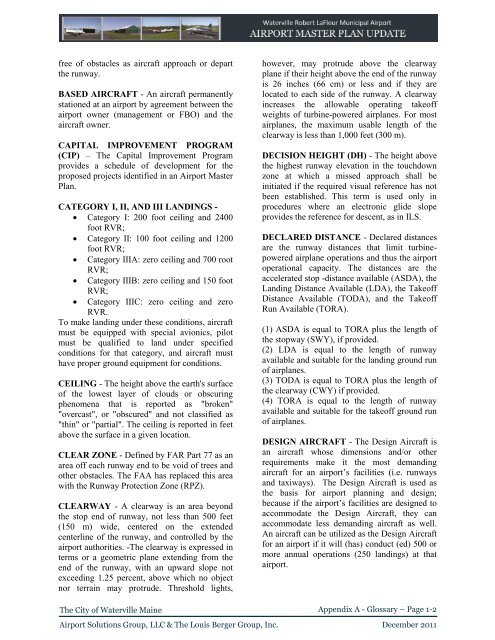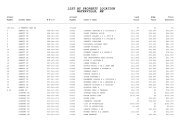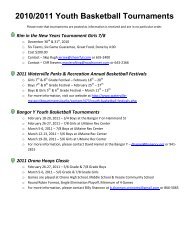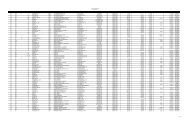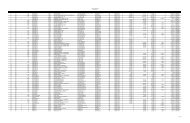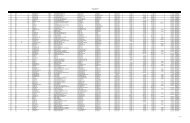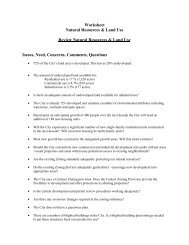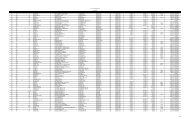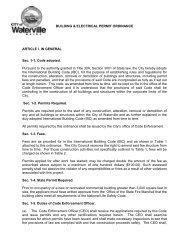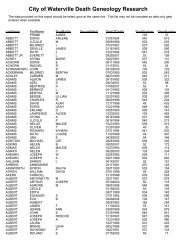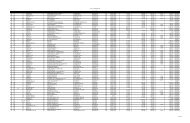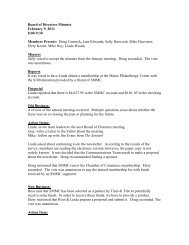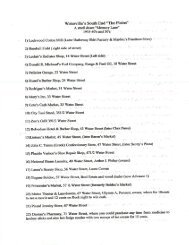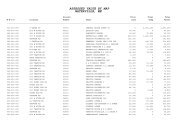Airport Master Plan 2012 - City of Waterville
Airport Master Plan 2012 - City of Waterville
Airport Master Plan 2012 - City of Waterville
Create successful ePaper yourself
Turn your PDF publications into a flip-book with our unique Google optimized e-Paper software.
free <strong>of</strong> obstacles as aircraft approach or depart<br />
the runway.<br />
BASED AIRCRAFT - An aircraft permanently<br />
stationed at an airport by agreement between the<br />
airport owner (management or FBO) and the<br />
aircraft owner.<br />
CAPITAL IMPROVEMENT PROGRAM<br />
(CIP) – The Capital Improvement Program<br />
provides a schedule <strong>of</strong> development for the<br />
proposed projects identified in an <strong>Airport</strong> <strong>Master</strong><br />
<strong>Plan</strong>.<br />
CATEGORY I, II, AND III LANDINGS -<br />
Category I: 200 foot ceiling and 2400<br />
foot RVR;<br />
Category II: 100 foot ceiling and 1200<br />
foot RVR;<br />
Category IIIA: zero ceiling and 700 root<br />
RVR;<br />
Category IIIB: zero ceiling and 150 foot<br />
<br />
RVR;<br />
Category IIIC: zero ceiling and zero<br />
RVR.<br />
To make landing under these conditions, aircraft<br />
must be equipped with special avionics, pilot<br />
must be qualified to land under specified<br />
conditions for that category, and aircraft must<br />
have proper ground equipment for conditions.<br />
CEILING - The height above the earth's surface<br />
<strong>of</strong> the lowest layer <strong>of</strong> clouds or obscuring<br />
phenomena that is reported as "broken"<br />
"overcast", or "obscured" and not classified as<br />
"thin" or "partial". The ceiling is reported in feet<br />
above the surface in a given location.<br />
CLEAR ZONE - Defined by FAR Part 77 as an<br />
area <strong>of</strong>f each runway end to be void <strong>of</strong> trees and<br />
other obstacles. The FAA has replaced this area<br />
with the Runway Protection Zone (RPZ).<br />
CLEARWAY - A clearway is an area beyond<br />
the stop end <strong>of</strong> runway, not less than 500 feet<br />
(150 m) wide, centered on the extended<br />
centerline <strong>of</strong> the runway, and controlled by the<br />
airport authorities. -The clearway is expressed in<br />
terms or a geometric plane extending from the<br />
end <strong>of</strong> the runway, with an upward slope not<br />
exceeding 1.25 percent, above which no object<br />
nor terrain may protrude. Threshold lights,<br />
however, may protrude above the clearway<br />
plane if their height above the end <strong>of</strong> the runway<br />
is 26 inches (66 cm) or less and if they are<br />
located to each side <strong>of</strong> the runway. A clearway<br />
increases the allowable operating take<strong>of</strong>f<br />
weights <strong>of</strong> turbine-powered airplanes. For most<br />
airplanes, the maximum usable length <strong>of</strong> the<br />
clearway is less than 1,000 feet (300 m).<br />
DECISION HEIGHT (DH) - The height above<br />
the highest runway elevation in the touchdown<br />
zone at which a missed approach shall be<br />
initiated if the required visual reference has not<br />
been established. This term is used only in<br />
procedures where an electronic glide slope<br />
provides the reference for descent, as in ILS.<br />
DECLARED DISTANCE - Declared distances<br />
are the runway distances that limit turbinepowered<br />
airplane operations and thus the airport<br />
operational capacity. The distances are the<br />
accelerated stop -distance available (ASDA), the<br />
Landing Distance Available (LDA), the Take<strong>of</strong>f<br />
Distance Available (TODA), and the Take<strong>of</strong>f<br />
Run Available (TORA).<br />
(1) ASDA is equal to TORA plus the length <strong>of</strong><br />
the stopway (SWY), if provided.<br />
(2) LDA is equal to the length <strong>of</strong> runway<br />
available and suitable for the landing ground run<br />
<strong>of</strong> airplanes.<br />
(3) TODA is equal to TORA plus the length <strong>of</strong><br />
the clearway (CWY) if provided.<br />
(4) TORA is equal to the length <strong>of</strong> runway<br />
available and suitable for the take<strong>of</strong>f ground run<br />
<strong>of</strong> airplanes.<br />
DESIGN AIRCRAFT - The Design Aircraft is<br />
an aircraft whose dimensions and/or other<br />
requirements make it the most demanding<br />
aircraft for an airport’s facilities (i.e. runways<br />
and taxiways). The Design Aircraft is used as<br />
the basis for airport planning and design;<br />
because if the airport’s facilities are designed to<br />
accommodate the Design Aircraft, they can<br />
accommodate less demanding aircraft as well.<br />
An aircraft can be utilized as the Design Aircraft<br />
for an airport if it will (has) conduct (ed) 500 or<br />
more annual operations (250 landings) at that<br />
airport.<br />
The <strong>City</strong> <strong>of</strong> <strong>Waterville</strong> Maine<br />
Appendix A - Glossary – Page 1-2<br />
<strong>Airport</strong> Solutions Group, LLC & The Louis Berger Group, Inc. December 2011


